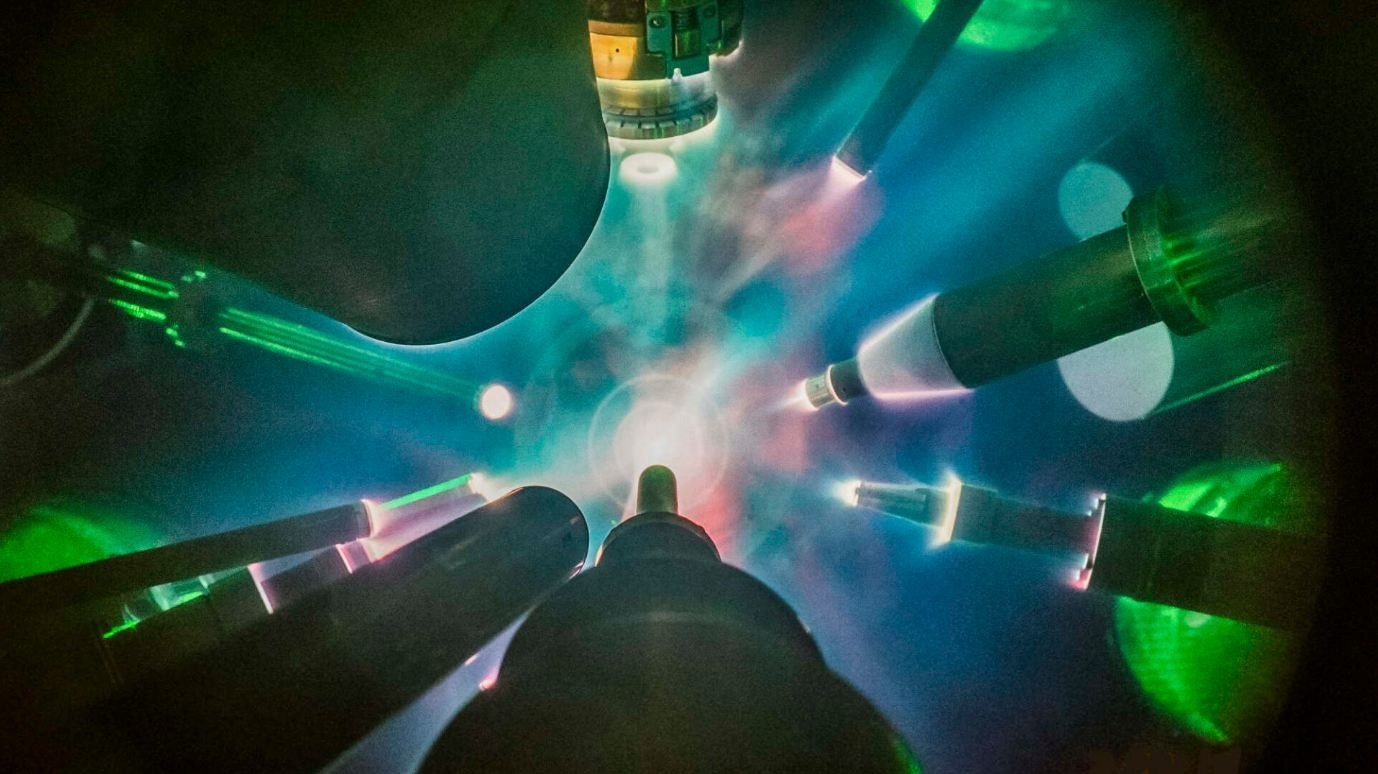Experiments conducted by researchers at the University of Rochester’s Laboratory for Laser Energetics (LLE) have demonstrated an efficient “spark plug” for inertial confinement fusion (ICF) techniques that use direct drive.

View from inside the OMEGA target chamber during a direct-drive inertial fusion experiment at the Laboratory for Laser Energetics. Scientists fired 28 kilojoules of laser energy at small capsules filled with deuterium and tritium fuel, causing the capsules to implode and produce a plasma hot enough to initiate fusion reactions between the fuel nuclei. Image Credit: University of Rochester Laboratory for Laser Energetics photo / Eugene Kowaluk
The authors of the two studies that were published in Nature Physics talk about their findings and suggest larger-scale applications for them in the hopes of one day creating fusion at a facility.
The OMEGA laser system, the world’s largest academic laser at less than one-hundredth the energy of the National Ignition Facility (NIF) at Lawrence Livermore National Laboratory in California, is housed in LLE, the largest university-based US Department of Energy program.
Scientists at Rochester have successfully fired 28 kilojoules of laser energy at small capsules containing tritium and deuterium fuel multiple times using OMEGA. This caused the capsules to implode and release a plasma hot enough to start fusion reactions between the fuel nuclei. More energy was produced by the fusion reactions sparked by the experiments than by the hot plasma in the center.
Unlike the NIF, which used an indirect drive method, the OMEGA experiments used direct laser illumination of the capsule. By converting the laser light into X-Rays, the indirect-drive method propels the capsule implosion. About 2,000 kilojoules of laser energy were used by the NIF to irradiate a capsule with X-Rays using an indirect drive. As a result, fusion ignition—a fusion reaction that produces a net gain of energy from the target—was achieved at NIF in 2022, marking a significant breakthrough.
Generating more fusion energy than the internal energy content of where the fusion takes place is an important threshold, now a staff scientist at Sandia National Labs in radiation and ICF target design. That’s a necessary requirement for anything you want to accomplish later on, such as burning plasmas or achieving ignition.
Connor Williams, Study Lead Author, Laboratory for Laser Energetics, University of Rochester
The Rochester team is enthusiastic about the possibility of using direct-drive techniques with more powerful lasers after demonstrating that they can attain this level of implosion performance using only 28 kilojoules of laser energy. Even though showing off a spark plug is a crucial step, OMEGA cannot compress enough fuel to reach ignition.
If you can eventually create the spark plug and compress fuel, direct drive has a lot of characteristics that are favorable for fusion energy compared to indirect drive. After scaling the OMEGA results to a few megajoules of laser energies, the fusion reactions are predicted to become self-sustaining, a condition called ‘burning plasmas.
Varchas Gopalaswamy, Scientist, Laboratory for Laser Energetics, University of Rochester
Gopalaswamy led the second study that explores the implications of using the direct-drive approach on megajoule-class lasers, similar to the size of the NIF. According to Gopalaswamy, a viable method for attaining thermonuclear ignition and net energy in laser fusion is direct-drive ICF.
A major factor contributing to the success of these recent experiments is the development of a novel implosion design method based on statistical predictions and validated by machine-learning algorithms
Riccardo Betti, Chief Scientist, Laboratory for Laser Energetics, University of Rochester
The Robert L. McCrory Professor in the Department of Mechanical Engineering and the Department of Physics and Astronomy says, “These predictive models allow us to narrow the pool of promising candidate designs before carrying out valuable experiments.”
Operating the intricate laser facility for the Rochester experiments required a highly coordinated effort from a large number of scientists, engineers, and technical staff. To carry out the experiments, they worked in conjunction with scientists from General Atomics and the MIT Plasma Science and Fusion Center. The National Nuclear Security Administration of the US Department of Energy provided funding for these experiments. Machine-learning applications supported by the DOE Fusion Energy Sciences program produced the target design work.
Journal References
Gopalaswamy, V., et al. (2024). Demonstration of a hydrodynamically equivalent burning plasma in direct-drive inertial confinement fusion. Nature Physics. doi.org/10.1038/s41567-023-02361-4.
Williams, C. A., et al. (2024). Demonstration of hot-spot fuel gain exceeding unity in direct-drive inertial confinement fusion implosions. Nature Physics. doi.org/10.1038/s41567-023-02363-2.